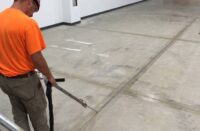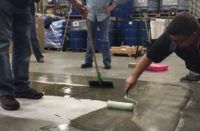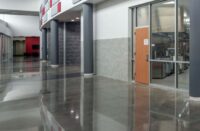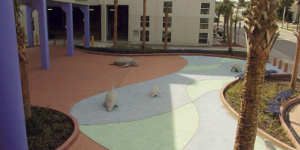
- A new concrete floor has dark, moist spots, even after it has cured. Floor coverings are ruined by this moisture.
- A driveway poured at 7:30 in the morning under ideal conditions doesn’t cure until 4 o’clock the next morning.
- A stamp project turns out with little tears across the texture because the surface crusted over too fast.
The culprit in each of these nightmare scenarios is an admixture improperly used. Of course, admixtures are intended to enhance the installation and/or performance of a finished project and in the vast majority of cases they do. However, when things go wrong, the remedy can be difficult and costly.
In the first instance, dark discoloration was caused by calcium chloride, used to accelerate the cure. Rick Smith of Richard Smith Custom Concrete, Canoga Park, Calif., says, “The number one nemesis is calcium chloride. It will draw moisture even after the concrete is cured. It can ruin a wooden floor laid over it.”
Gabriel Ojeda explains, “The main problem with calcium chloride is the chloride ion. The chloride ion plus water causes corrosion. Alternative accelerators do not contain this ion, so they do not corrode steel or affect colors.” Ojeda is president of the admixture manufacturer Fritz-Pak Corporation of Dallas, Texas. He goes on to explain that accelerators are used to save time, such as when pouring concrete in cooler temperatures. During a short winter day with high temperatures in the 40s, the concrete can take all day to set unless an accelerator is used. While calcium chloride can be used in applications like a foundation or a warehouse where the floor will be dry, for decorative applications Ojeda recommends using a non-chloride alternative even though the material cost can be four to five times as much. Bob Harris of the Decorative Concrete Institute, Temple, Georgia, concurs. He says, “As a general rule, we use non calcium-based accelerating admixtures.”
Too much accelerator, even the right one, can cause trouble too, according to Chris Sullivan, national sales manager for QC Construction Products, Madera, Calif. “When there is too much accelerator in a mix and it cures too fast, the slab gets away from the contractor before he can stamp it. Most problems with admixtures are due to overdosing or underdosing.”
 Admixtures for retarding the cure sometimes have unexpected outcomes too. Smith recalls walking the beach near his customer’s home all night, wondering if the concrete he poured early that morning would ever set or if he would have to rip the whole project out and begin again. The problem was the interaction of two admixtures. The concrete contained a water-reducing agent and a retarder. “The water-reducing agent reduced the water by 30 percent, but the amount of retarder used was based on a full water load,” Smith explains. “So the slab didn’t cure until 4:00 the next morning.”
Admixtures for retarding the cure sometimes have unexpected outcomes too. Smith recalls walking the beach near his customer’s home all night, wondering if the concrete he poured early that morning would ever set or if he would have to rip the whole project out and begin again. The problem was the interaction of two admixtures. The concrete contained a water-reducing agent and a retarder. “The water-reducing agent reduced the water by 30 percent, but the amount of retarder used was based on a full water load,” Smith explains. “So the slab didn’t cure until 4:00 the next morning.”
According to Bob Harris, a good percentage of concrete mix designs already include a mid-range water-reducing admixture, which gives you a water reduction of somewhere between 5 percent and 10 percent. He explains that most mid-range water reducers have a slight effect on the setting times, making the underlying concrete set more slowly while the surface crusts over. “When you stamp a mix like this,” he says, “you inevitably end up with little tears across the surface of your texture. My personal experiences when pouring color hardened concrete with two or more admixtures in the mix has proven to be a challenging ordeal.”
Set retarders must be added to the mix in the right proportions. Ojeda says that not adding enough will make the concrete start hardening before the decorative finish can be applied. Adding too much has two possible outcomes, depending on the chemistry. “With an overdose, it is either a matter of time or a matter of life or death. Either it takes too long to set, or it never sets. The water evaporates, the concrete dries out and it just crumbles — you end up with sand and gravel. There is no remedy for this catastrophic failure.”
Two other common admixtures should be mentioned here. Air-entraining admixtures increase durability during freeze-thaw cycles. However, too much air weakens the concrete and it loses strength. Chris Sullivan adds that too much air can lighten the color as well.
Superplasticizers increase workability without additional water, but too much plasticizer can result in material segregation and excessive bleed water. It can also affect final color.
What’s a contractor to do?
In windy, sunny conditions when the surface is curing too quickly, Bob Harris suggests using a spray-applied evaporation retarder to lock in moisture. “I will sometimes cover the slab with 6 mil plastic for 10 or so minutes between dry shake applications to help draw moisture to the surface without adding more water,” he adds.
One way to slow down the cure without an admixture is to ask the ready-mix supplier to use chilled water in the mix. Rick Smith remembers trying this on a challenging project. He says, “We didn’t have one crack at 106 degrees and high winds.”
When conditions are variable and the set time can’t be accurately controlled or predicted, Smith recommends having extra crew on hand for finishing. “It may increase labor costs,” he says, “but it’s like paying for an insurance policy, even if they just stand there and look at it. One time we had to stamp 15 minutes after we poured, the concrete was curing so fast.”
Microtoppings and overlays offer an alternative to tearing out a slab. When problems with a set retarder result in poor stamping quality, a contractor gets a second chance with a stampable overlay. An overlay gives the customer the added benefit of an extremely strong surface.
A pound of prevention…
Of course, avoiding problems in the first place is much better than fixing them later. “Successful decorative concrete installations are a total team effort, starting with the ready mix producer,” Harris says. “As a contractor, it is your responsibility to understand mix designs that include admixtures and make sure that you order the appropriate mix. We have six or seven mix designs we use on a regular basis because we are able to partner with our ready-mix producer. The bottom line with mixes is, keep it simple! Don’t try to re-invent the wheel.”
Smith agrees. “Get to know the chemist at your ready mix plant,” he says. “Try to stick with proven mixes.” Ojeda takes a serious view of the contractor’s responsibility. “The contractor should tell the ready mix supplier exactly what he wants the concrete to do.” Being specific about requirements and understanding what is going into the mix are key to avoiding admixture problems.
While there can be some hair-raising moments when admixtures are used improperly, in the vast majority of cases they make decorative concrete installations easier and more successful. “Admixtures are a means to get from point A to point B,” Smith says. “They are not a fix-all, but they are another tool in the arsenal.”
Chris Sullivan goes further. “There aren’t that many issues created by admixtures. Admixtures are your best friends in decorative concrete — they give you more time or speed things up so you can control the pace. They increase strength. The benefits of admixtures far outweigh any problems.”















